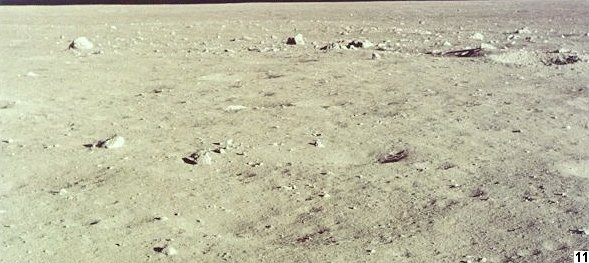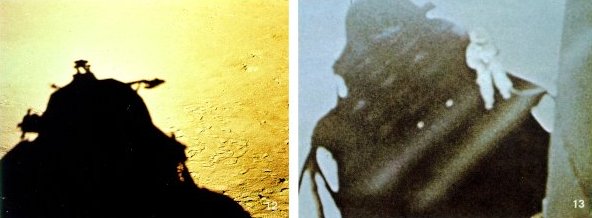ARMSTRONG
A number of experts had, prior to the flight,
predicted that a good bit of difficulty might be
encountered by people attempting to work on
the surface of the Moon due to the variety of strange atmospheric
and gravitational characteristics that would be
encountered. This didn't prove to be the case and after landing we
felt very comfortable in the lunar gravity. It was,
in fact, in our view preferable both to weightlessness and to the
Earth's gravity. All the systems on the LM were
operating magnificently -- we had very few problems.
We decided to go ahead with the surface work
immediately. We predicted that we might be ready
to leave the LM by 8 o'clock, but those of you who
followed on the ground recognize we missed
our estimate a good deal. This was due to a
number of factors:
- we had housekeeping to
perform (food packages, flight plans, all the
items that we had used in the previous descent had
to be stowed out of the way prior to
depressurizing the lunar module)
- it took longer to
depressurize the lunar module than we had anticipated
and
- it also took longer to get the cooling units in our
backpacks operating than we had expected.
In substance, it took us approximately an hour
longer to get ready than
we had predicted. When we actually descended the
ladder it was found to be very much like the
lunar gravity simulations we had performed here
on Earth. No difficulty was encountered in descending the ladder.
The last step was about 3 1/2 feet trom the surface,
and we were somewhat concerned that we might have difficulty
in reentering the LM at the end of our activity
period. So we practiced that before doing the exercise of bringing
the camera down which took the subsequent surface
pictures. Here you see the camera being lowered on what might be
called the "Brooklyn clothesline." (Photo 13.) I
was operating quite carefully here because immediately to my right
and off the picture was a six-foot-deep crater.
And I was somewhat concerned about losing my balance on the
steep slope. The other item of interest in the very
early stages of EVA, should it have been cut short for some unknown
reason, was the job of bringing back a sample
of the lunar rocks. The photograph shows
the collection of that initial
sample into a small bag (Photo 14) and then that
bag being deposited in my pocket. This was the first of a number
of times when we found two men were a great help.
I quickly put up the TV camera. And then more leisurely Buzz
and I joined together to erect the American flag.
(Photo 15.) We found on a number of occasions when we were
able to help each other in many ways on the surface.
You probably recall the times that I got my foot caught in the
television cable, and Buzz was able to help me extract
it without falling down.
|
|





















